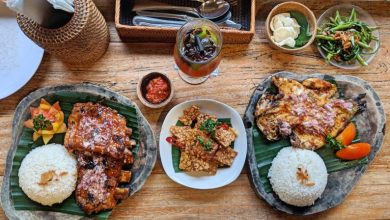Bali’s Culinary Tapestry: A Feast of Flavors Amidst Cultural Riches
Bali's Culinary

Introduction
Bali, also known as the Island of the Gods, is well-known for its rich and varied food scene in addition to its stunning scenery and lively cultural traditions. Balinese food is a delectable blend of regional flavors, historical inspirations, and a strong bond with the island’s spiritual and cultural legacy. This essay will examine the complexities of Bali’s cuisine, focusing on the island’s distinctive dishes, cultural importance, and changing culinary scene, which has grown to be a major draw for both residents and visitors.
Local Flavors and Ingredients
A symphony of tastes reflecting the island’s tropical environment, rich natural resources, and fertile soil is at the core of Balinese cuisine. Almost every Balinese meal starts with rice, which is revered as a basic food. Bali’s complex rice farming system, or Subak, not only keeps the island alive but also influences the island’s culture and spirituality.
Herbs, spices, and fragrant pastes are used with such vibrancy in Balinese cuisine. Bumbu Bali, a multipurpose spice mix that usually contains spices like turmeric, galangal, ginger, shallots, garlic, and chilli, is a prime example. Many Balinese meals are based on this fragrant blend, which gives them a mouthwatering depth of flavor.
Fresh seafood from the nearby waterways is another highlight of Balinese cooking. Before being cooked to perfection, grilled fish, plump prawns, and calamari are frequently marinated in a flavorful blend of Balinese spices. The sea wind combines with the tantalizing scent of cooked fish at the well-known Jimbaran Bay seafood eateries, providing a sensory experience.
The main components that give many Balinese meals their sweetness and richness are coconut, coconut milk, and palm sugar. A few of instances of how these components are deftly interwoven into the island’s culinary repertoire include Lawar, a typical minced beef dish, and Laklak, a sweet rice flour pancake.


Traditional Balinese Dishes
Balinese food offers a vast array of delectable options, from simple street food to intricate ceremonial feasts. Indonesian fried rice, or Nasi Goreng, is a common comfort meal that is loved by both residents and tourists. It is frequently served with satay, which is topped with a fried egg and skewers of marinated and grilled meat. Nasi Goreng’s rich blend of shallots, garlic, tamarind, chilli, and sweet soy sauce makes it a filling and popular meal.
Balinese tradition places great importance on the ceremonial dish known as babi guling, or suckling pig. Babi Guling is a delicacy that is prepared at religious rituals and special events. It is made by slowly roasting an entire pig, which produces crispy skin and soft flesh. From the delicious scent of the roasting pig to the pleasure of relishing every juicy mouthful, the meal is a sensory delight.
The Balinese dish known as lawar, which was previously stated, is a typical mixture of finely chopped meat, grated coconut, rich herbs, and certain spices. It displays the painstaking preparation and creative taste combinations that characterize Balinese cooking. Lawar embodies the social spirit of Balinese eating and is typically offered during religious events and family get-togethers.
Food and Balinese Culture
Food in Bali is more than simply nourishment; it is a representation of the social ties, spirituality, and dynamic culture of the island. Food offerings, or “banten,” are inextricably related to Balinese rites and rituals. As a thank you to the gods, these carefully constructed offerings—made of rice, fruits, and other symbolic materials—are placed in front of temples, shrines, and residences.
The idea of “Tri Hita Karana,” which roughly translates to “three causes of well-being,” emphasizes how interwoven Balinese culture is. It highlights the harmony that exists between the divine, nature, and people. This ideology places a strong emphasis on food as a symbol of the connection between the social, spiritual, and physical facets of life.
Balinese traditional markets, like Denpasar’s heaving Pasar Badung, are lively centers of activity where both residents and tourists can observe how important food is to Balinese culture. The markets provide a dizzying selection of fresh vegetables, spices, and regional specialties. They are a kaleidoscope of colors and scents. Balinese civilization is characterized by a sense of community, which is reflected in the markets’ lively banter and trade of commodities.
Conclusion
In summary, Bali’s food scene is an intriguing patchwork of tastes, customs, and inventions. Deeply ingrained in spiritual and cultural traditions, Balinese food is always changing to meet the demands of tourism and globalization. The fusion meals that are popping up from fashionable cafés in Ubud to the traditional tastes of Babi Guling and Lawar, Bali’s culinary landscape is a tribute to the island’s adaptability and capacity to welcome change while maintaining its rich cultural history.


In Bali, eating is a celebration of life, community, and the interdependence of all things rather than just a means of subsistence. Bali’s culinary tapestry invites everyone to experience the flavors and customs that make the island a genuinely enthralling destination for food connoisseurs and cultural explorers alike, serving as a portal to the island’s character as it continues to welcome tourists from all over the world.





